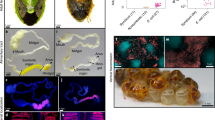Abstract
Strains of Enterobacter agglomerans and Klebsiella pneumoniae isolated from Rhagoletis completa Cresson were engineered to express transgenic fluorescent proteins (ECFP, DsRed). These bacteria were introduced into flies by feeding the flies a sucrose solution in which the bacteria were suspended. The transgenic and heterologous marker protein was expressed and visible in the bacteria after they were ingested by WHF and while they were in the fly gut. We describe the plasmids used to transform these bacteria and demonstrate expression of heterologous proteins from the transforming plasmids and discuss the implications for future pest control strategies.
Similar content being viewed by others
Author information
Authors and Affiliations
Additional information
Received: 14 September 2001 / Accepted: 22 October 2001
Rights and permissions
About this article
Cite this article
Peloquin, J., Lauzon, C., Potter, S. et al. Transformed Bacterial Symbionts Re-Introduced to and Detected in Host Gut. Curr Microbiol 45, 41–45 (2002). https://doi.org/10.1007/s00284-001-0045-1
Issue Date:
DOI: https://doi.org/10.1007/s00284-001-0045-1




